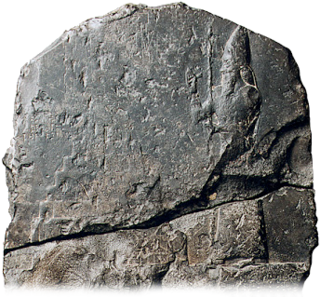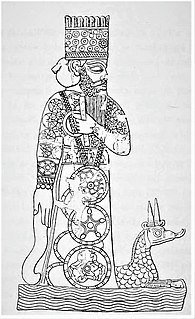Related Research Articles

Chaldea was a small country that existed between the late 10th or early 9th and mid-6th centuries BC, after which the country and its people were absorbed and assimilated into the indigenous population of Babylonia. Semitic-speaking, it was located in the marshy land of the far southeastern corner of Mesopotamia and briefly came to rule Babylon. The Hebrew Bible uses the term כשדים (Kaśdim) and this is translated as Chaldaeans in the Greek Old Testament, although there is some dispute as to whether Kasdim in fact means Chaldean or refers to the south Mesopotamian Kaldu.

Sennacherib was the king of the Neo-Assyrian Empire from the death of his father Sargon II in 705 BC to his own death in 681 BC. The second king of the Sargonid dynasty, Sennacherib is one of the most famous Assyrian kings for the role he plays in the Hebrew Bible, which describes his campaign in the Levant. Other events of his reign include his destruction of the city of Babylon in 689 BC and his renovation and expansion of the last great Assyrian capital, Nineveh.

The 7th century BC began the first day of 700 BC and ended the last day of 601 BC.

Babylonia was an ancient Akkadian-speaking state and cultural area based in central-southern Mesopotamia and parts of Syria. A small Amorite-ruled state emerged in 1894 BC, which contained the minor administrative town of Babylon. It was a small provincial town during the Akkadian Empire but greatly expanded during the reign of Hammurabi in the first half of the 18th century BC and became a major capital city. During the reign of Hammurabi and afterwards, Babylonia was called "the country of Akkad", a deliberate archaism in reference to the previous glory of the Akkadian Empire.

Nebuchadnezzar II, also spelled Nebuchadrezzar II, was the second king of the Neo-Babylonian Empire, ruling from the death of his father Nabopolassar in 605 BC to his own death in 562 BC. Historically known as Nebuchadnezzar the Great, he is typically regarded as the empire's greatest king. Nebuchadnezzar remains famous for his military campaigns in the Levant, for his construction projects in his capital, Babylon, and for the important part he played in Jewish history. Ruling for 43 years, Nebuchadnezzar was the longest-reigning king of the Chaldean dynasty. At the time of his death, Nebuchadnezzar was among the most powerful rulers in the world.

Esarhaddon, also spelled Essarhaddon, Assarhaddon and Ashurhaddon was the king of the Neo-Assyrian Empire from the death of his father Sennacherib in 681 BC to his own death in 669. The third king of the Sargonid dynasty, Esarhaddon is most famous for his conquest of Egypt in 671 BC, which made his empire the largest the world had ever seen, and for his reconstruction of Babylon, which had been destroyed by his father.

Elam was an ancient civilization centered in the far west and southwest of modern-day Iran, stretching from the lowlands of what is now Khuzestan and Ilam Province as well as a small part of southern Iraq. The modern name Elam stems from the Sumerian transliteration elam(a), along with the later Akkadian elamtu, and the Elamite haltamti. Elamite states were among the leading political forces of the Ancient Near East. In classical literature, Elam was also known as Susiana, a name derived from its capital Susa.

Shamash-shum-ukin, was king of Babylon as a vassal of the Neo-Assyrian Empire from 668 BC to his death in 648. Born into the Assyrian royal family, Shamash-shum-ukin was the son of the Neo-Assyrian king Esarhaddon and the elder brother of Esarhaddon's successor Ashurbanipal.

Nebuchadnezzar I or Nebuchadrezzar I, reigned c. 1121–1100 BC, was the fourth king of the Second Dynasty of Isin and Fourth Dynasty of Babylon. He ruled for 22 years according to the Babylonian King List C, and was the most prominent monarch of this dynasty. He is best known for his victory over Elam and the recovery of the cultic idol of Marduk.
Nergal-ushezib, originally Shuzub, was a Babylonian nobleman who was installed as King of Babylon by the Elamites in 694 BC, after their capture of Babylon and deposition and murder of the previous king Ashur-nadin-shumi, son of King Sennacherib of Assyria.
Ashur-nadin-shumi was a son of the Neo-Assyrian king Sennacherib and was appointed by him as the king of Babylon, ruling southern Mesopotamia from 700 BC to his capture and execution by the Elamites in 694 BC. Ashur-nadin-shumi was probably Sennacherib's firstborn son and his first crown prince and thus the designated successor to the Assyrian throne.
Bel-ibni was a Babylonian nobleman who served as King of Babylon for several years as the nominee of the Assyrian king Sennacherib.
The Battle of Diyala River took place in 693 BC between the forces of the Neo-Assyrian Empire and the Elamites of southern Iran.

The Neo-Assyrian Empire was the fourth and penultimate stage of ancient Assyrian history and the final and greatest phase of Assyria as an independent state. Beginning with the accession of Adad-nirari II in 911 BC, the Neo-Assyrian Empire grew to dominate the ancient Near East throughout much of the 8th and 7th centuries BC, becoming the largest empire in history up to that point. Because of its geopolitical dominance and ideology based in world domination, the Neo-Assyrian Empire is by many researchers regarded to have been the first world empire in history. At its height, the empire was the strongest military power in the world and ruled over all of Mesopotamia, the Levant and Egypt, as well as portions of Anatolia, Arabia and modern-day Iran and Armenia.
The Battle of Halule took place in 691 BC between the Assyrian empire and the rebelling forces of the Babylonians, Chaldeans, Persians, Medes, Elamites and Aramaic tribes.

The siege of Babylon in 689 BC took place after Assyrian king Sennacherib's victory over the Elamites at the Battle of River Diyala. Although the Assyrians had suffered heavy casualties at the river, they had beaten the Elamites such that the Babylonians now stood alone. Sennacherib then successfully besieged Babylon and destroyed it.

The timeline of ancient Assyria can be broken down into three main eras: the Old Assyrian period, Middle Assyrian Empire, and Neo-Assyrian Empire. Modern scholars typically also recognize an Early period preceding the Old Assyrian period and a post-imperial period succeeding the Neo-Assyrian period.

The Sargonid dynasty was the final ruling dynasty of Assyria, ruling as kings of Assyria during the Neo-Assyrian Empire for just over a century from the ascent of Sargon II in 722 BC to the fall of Assyria in 609 BC. Although Assyria would ultimately fall during their rule, the Sargonid dynasty ruled the country during the apex of its power and Sargon II's three immediate successors Sennacherib, Esarhaddon and Ashurbanipal are generally regarded as three of the greatest Assyrian monarchs. Though the dynasty encompasses seven Assyrian kings, two vassal kings in Babylonia and numerous princes and princesses, the term Sargonids is sometimes used solely for Sennacherib, Esarhaddon and Ashurbanipal.

The Statue of Marduk, also known as the Statue of Bêl, was the physical representation of the god Marduk, the patron deity of the ancient city of Babylon, traditionally housed in the city's main temple, the Esagila. There were seven statues of Marduk in Babylon, but 'the' Statue of Marduk generally refers to the god's main statue, placed prominently in the Esagila and used in the city's rituals. This statue was nicknamed the Asullḫi and was made of a type of wood called mēsu and covered with gold and silver.
References
- ↑ Grayson, Albert Kirk (2 November 2018). Assyrian and Babylonian Chronicles. Eisenbrauns. ISBN 9781575060491 – via Google Books.
- ↑ Jean-Jacques Glassner, Mesopotamian Chronicles, Atlanta, 2004, p. 199.
This article needs additional citations for verification .(December 2009) |